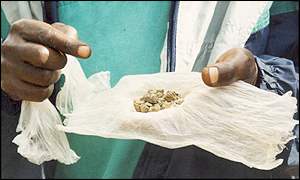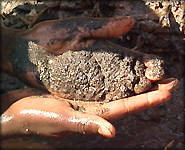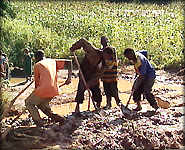http://www.raceandhistory.com/
|
Cell phones, Laptops, Pagers and Congo's Coltan Originally Published, January 21, 2002, ABC NEWS  DRC is home to 80% of the world's coltan reserves PHOTO: BBC You may not have heard of coltan, but you have it in your cell phone, laptops, pagers and other electronic devices. It is important to everyday communication in the United States, but it is making the conflict in Congo more complicated. What Is Coltan?  Columbite-tantalite — coltan for short — is a dull metallic ore found in major quantities in the eastern areas of Congo. When refined, coltan becomes metallic tantalum, a heat-resistant powder that can hold a high electrical charge. These properties make it a vital element in creating capacitors, the electronic elements that control current flow inside miniature circuit boards. Tantalum capacitors are used in almost all cell phones, laptops, pagers and many other electronics. The recent technology boom caused the price of coltan to skyrocket to as much as $400 a kilogram at one point, as companies such as Nokia and Sony struggled to meet demand. Columbite-tantalite — coltan for short — is a dull metallic ore found in major quantities in the eastern areas of Congo. When refined, coltan becomes metallic tantalum, a heat-resistant powder that can hold a high electrical charge. These properties make it a vital element in creating capacitors, the electronic elements that control current flow inside miniature circuit boards. Tantalum capacitors are used in almost all cell phones, laptops, pagers and many other electronics. The recent technology boom caused the price of coltan to skyrocket to as much as $400 a kilogram at one point, as companies such as Nokia and Sony struggled to meet demand.How Is Coltan Mined?  Coltan is mined through a fairly primitive process similar to how gold was mined in California during the 1800s. Dozens of men work together digging large craters in streambeds, scraping away dirt from the surface in order to get to the coltan underground. The workers then slosh water and mud around in large washtubs, allowing the coltan to settle to the bottom due to its heavy weight. A good worker can produce one kilogram of coltan a day. Coltan is mined through a fairly primitive process similar to how gold was mined in California during the 1800s. Dozens of men work together digging large craters in streambeds, scraping away dirt from the surface in order to get to the coltan underground. The workers then slosh water and mud around in large washtubs, allowing the coltan to settle to the bottom due to its heavy weight. A good worker can produce one kilogram of coltan a day. Coltan mining is very well paid in Congo terms. The average Congolese worker makes $10 a month, while a coltan miner can make anywhere from $10 to $50 a week. Financing the Conflict A highly controversial U.N. Security Council report recently outlined the alleged exploitation of natural resources, including coltan, from Congo by other countries involved in the current war. There are reports that forces from neighboring Rwanda, Uganda and Burundi are involved in smuggling coltan from Congo, using the revenues generated from the high price of coltan to sustain their efforts in the war. By one estimate, the Rwandan army made at least $250 million over a period of 18 months through the sale of coltan, even though no coltan is mined in Rwanda. All countries involved in the war deny exploiting Congo's natural resources. Environmental Consequences In order to mine for coltan, rebels have overrun Congo's national parks, clearing out large chunks of the area's lush forests. In addition, the poverty and starvation caused by the war have driven some miners and rebels to hunt the parks' endangered elephants and gorillas for food. In Kahuzi Biega National Park, for example, the gorilla population has been cut nearly in half, from 258 to 130. Tracing the Source The path that coltan takes to get from Central Africa to the world market is a highly convoluted one, with legitimate mining operations often being confused with illegal rebel operations, and vice versa, making it difficult to trace the origin. To be safe, in recent months many electronics companies have publicly rejected the use of coltan from anywhere in Central Africa, instead relying on their main suppliers in Australia. American-based Kemet, the world's largest maker of tantalum capacitors, has asked its suppliers to certify that their coltan ore does not come from Congo or bordering countries. But it may be a case of too little, too late. Much of the coltan illegally stolen from Congo is already in laptops, cell phones and electronics all over the world. Congo War and the Role of Coltan - Natalie D. Ware Congo's coltan rush - BBC |